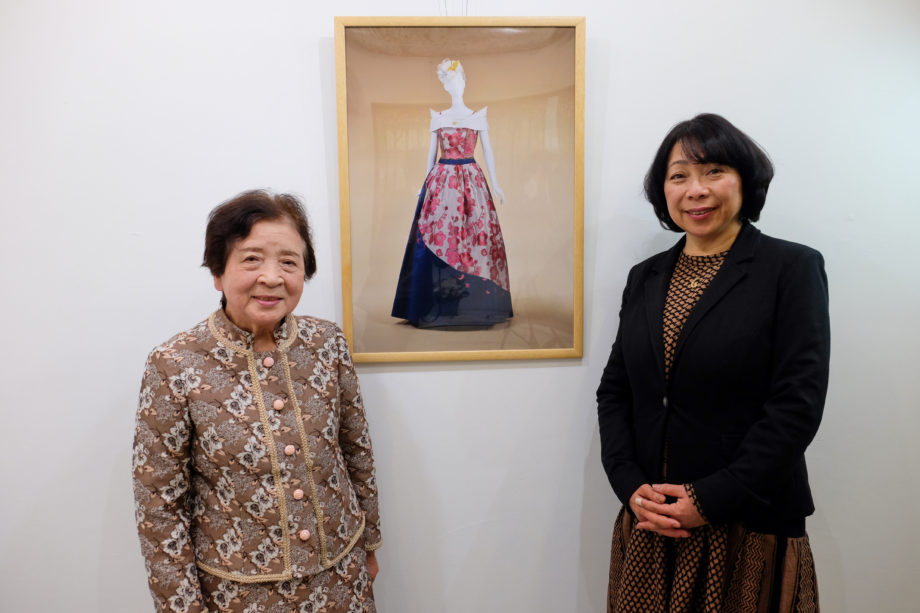- JEPAA Member
- Western dress
- Yoshie Senda
- 洋装
- 千田芳江
© 2024 Yoshie Senda.
SCROLL
Portfolio /作品一覧
- マウント富士(前) / Mount Fuji (front)
- マウント富士(後)/ Mount Fuji (back)
view more
Interview article /対談記事
2023年特別対談 千田芳江×ジャン・イーヴ

まほろばの月に込めた
平和へのメッセージ
ジャン・イーブ(以下 ジャン):千田先生、今日はよ ろしくお願いします。早速ですが今回の池袋展の作品 『まほろばの月』についてお話を伺えますか?
千田芳江(以下 千田):これは西暦700年ごろ、飛鳥 時代の服装をイメージして制作した作品です。
ジャン:「まほろば」とはどういう意味なのでしょう か。
千田:「まほろば」は日本の古語です。「住み良い里」と いう意味で使われていたようです。確かに戦いは各地 であったと思いますが、現代のように悲惨な戦争はな かったと思います。そんな平和な古代の時代、若者た ちは何を考えながら生きていたのだろうと。何を思っ て月を見上げていたのだろうと想像しながら制作いた しました。
ジャン:とても世界観が表現されています。色彩も宝 箱の中のように鮮やかで、まさにアートといえます。 非常に静かで穏やかで優しい。
千田:当時の男性たちは腰よう帯たいに刀をぶら下げていたん です。しかしそれは平和ではありませんし、「まほろ ば」という言葉に適していません。ここでは剣つるぎを外し て尺八を持たせました。だから優しく見えるのかもし れませんね。
ジャン:先生はいつもドレスを通してメッセージを伝 えていらっしゃいますね。
千田:そうですね。2021年にケベックに出品した「紅 梅と鶴」も、コロナで気持ちが沈んだ社会に対して何 かエネルギーを与えたいと思い制作した作品です。
ジャン:以前拝見させていただいて心に残っていた作 品だったので、その中の意図を知ることができて嬉し いです。ただ今回の出品作は、ただ伝統的というわけ ではなく、先生の解釈が見えるという点でも、これま での作品とは違う印象があります。
千田:ありがとうございます。自分なりに当時の印象 や空気が伝わるものをと考えました。例えば2年前くらいに正倉院 ※ 1 に関しての展覧会が東京のサント リー美術館で開かれていました。そこで正倉院蔵の織 物の複製品宝物の再現に使われていたのが川島織物 ※ 2 の布だったのです。同社製の帯は私も既に持っていた ので、その布を使って制作しようと思いつきました。
ジャン:なるほど。発見があってそれが形になるのは 絵や彫刻といったものと全く同じですね。これはどの ように縫製されたのですか?
千田:これは手縫いとミシンで縫製をしています。手 縫いの部分は着物の縫い方を使って縫いました。また 着物を解いた八掛 ※ 3 の裏地も使いました。
ジャン:やはり日本の伝統の縫い方が生かされている わけですね。しかしお話を聞いていると、飛鳥時代の 文化を調べたり、技法も当時のものを使ったりと、か なり苦労されたのではありませんか?
千田:そうですね、服の製作だけでなく飛鳥時代の資 料や文献の調査まで合わせると、完成までに4年くら いかかりました。
ジャン:それはすごい!大仕事だったのですね。確か にこの作品であればそれくらいの時間がかかっていて も不思議ではありません。
千田:ただこちらの作品は私個人の作品ではなく、制 作には多くの方々が協力してくれました。調べ物につ いては高校生の男の子がよく手伝ってくれまして、そ れがあったからこの作品ができたと思っているのでと ても感謝しています。例えばモデルの男性が手に持っ ているのは古代の尺八の模造品で、その細部に至るま で多くのアドバイスをいただきました。
ジャン:なるほど、素晴らしい協力者がいらっしゃっ たからこそ、この一枚の写真の中には先生の表現した い世界観がはっきりと表れているのですね。
千田:そうおっしゃって頂けると嬉しいです。制作工 程でも10 名くらいの方に協力をしていただきました。 手伝ってくれたのは私の洋裁学校の生徒さんたちで、 みんなで情報を共有して、話し合いを重ねながら形に していったものです。生徒さんといってもみんな高い 技術を持っているので、本当にみんなで作り上げた作 品だと思います。
ジャン:多くの方の技術や知恵が集まってこの作品が できたのですね。本日こうしてお話をお伺いして、千田先生の作品に込められた意味やストーリーをお伝えしていきたいと思いました。
千田:ありがとうございます。やはり意味を持って作 品を制作するのはとても大切だと思っています。
ジャン:そうですね。芸術家はどの時代でもその時々 に伝えるべき思いを作品にして発表してきました。先 生も芸術家として今後も思いを伝える作品を制作して いっていただきたいと思います。また新たな作品を心 より楽しみにしております。
※1 正倉院:奈良市東大寺大仏殿の西北にある宝庫。 天平時代の建造で、 校倉(あぜくら)造りの北倉・南倉を、板倉である中倉がつなぐ。宝物には、聖武天皇の遺愛品や東大寺の文書・寺宝などのほか、ペルシアおよびアジア各地の遺品も含まれ、東洋美術の粋を伝える。
※2 川島織物:初代川島甚兵衛によって設立された京都西陣織の名門繊維会社。2006 年に神戸の有力インテリアメーカー「セルコン」と合併し、現在は「川島織物セルコン」となる。和装の製作技術において日本トップの織物会社の一つに数えられ、2022 年の「よみがえる正倉院宝物」展(サントリー美術館)では、「紫地鳳唐草丸文錦」の再現模造が公開され、大きな反響を呼んだ。
※3 八掛:袷の着物の裾の裏につける布。 身ごろの裾に四布、おくみに二布、衿先に二布合わせて八つに裁って掛け合わせたことから、八掛という。 着物の表地の保護と、裾捌きを良くする効果もある。 動作によっては目に触れることも多いため、裾や袖口からちらりと見える色にこだわるなど、隠れたおしゃれを楽しめる部位。
Special conversation,Yoshie Senda and Tomoko Germar ,2023
A message of peace in the moon of mahoroba
Jean-Yves Chrétien: Ms. Senda, it is lovely to meet you today. Could you tell us about your work “The Moon of Utopia” exhibited at the Ikebukuro exhibition?
Yoshie Senda: This piece is inspired by the clothing of the Asuka period, around the year 700 A.D.
Jean: And what does“ Mahoroba” mean?
Senda: “Mahoroba” is an ancient Japanese word. The phrase was used to mean “an excellent place to live.” Battles were certainly fought all over the land, but I don’t think there were any disastrous wars as there are today. While creating this piece, I wondered what young people were thinking as they lived in those peaceful ancient times. I also wondered what they were thinking as they looked up at the moon.
Jean: It expresses its unique ambience. The colors are as vivid as a treasure chest. It’s truly a work of art. And it’s very quiet, calm, and gentle.
Senda: In those days, men used to hang swords from their waistbands. But that’s not peaceful, and it’s not suited to the phrase “mahoroba.” So I took the sword and let the model have a shakuhachi flute. Maybe that’s why it seems so gentle.
Jean: You’re always conveying a message through your dresses, aren’t you?
Senda: Yes, that’s right.“ Red Plum Blossom and Crane,” which I exhibited in Quebec in 2021, is another work that I created to inject some energy into a society that was feeling down during the COVID era.
Jean: I’m so glad to hear about your intention behind that work, because I’ve seen it before and it made an impression on me. But I get the impression that your work in this exhibition differs from your previous works. This time it is not only traditional, but also your own interpretation is more evident.
Senda: Thank you very much. In my own way, I tried to convey some impressions and the atmosphere of the time. For example, about two years ago, an exhibition on the Shosoin Treasures was held at the Suntory Museum of Art in Tokyo. I found that the fabrics by Kawashima Orimono Inc. were used to create the reproductions of textile treasure. Since I already had a traditional obi waistband made by the company, I came up with the idea of using their fabric for my own works.
Jean: I see. Just like a painting or a sculpture, when a new discovery is made, it takes shape. How did you sew it?
Senda: Both by hand and with a sewing machine. The hand-sewn part was done using the same sewing method to create kimonos. I also used the lining from a kimono that had been taken apart.
Jean: I see that you’re making use of traditional Japanese sewing methods. Incidentally, listening to your story, I assume there were some difficulties researching the culture of the Asuka period and using techniques from that period.
Senda: Yes, it took me about four years to complete the project — not simply to make the clothes, but also to research materials and documents from the Asuka period.
Jean: That’s amazing! It must have been a huge undertaking. Certainly, for a piece like this, I’m not surprised it took that long.
Senda: However, this piece was not entirely my own. Many people cooperated with me in creating it. I am very grateful to a high school student who helped me a lot with the research, whose help has really made this work possible. For example, the male model is holding a replica of a classical shakuhachi flute. He advised me thoroughly on every detail of it.
Jean: I see. Thanks to your wonderful collaborator, the unique ambience you wanted to express is clearly expressed in this one photograph.
Senda: I am glad to hear you say so. Also, during the production process, about 10 people cooperated with me. They were the students from my dressmaking class. We all shared information and discussed various aspects over and over as the piece took shape. All of those students have a high level of technical skill, so I think this is truly a work of art created by all of us together.
Jean: So many people’s skills and wisdom came together to create this work. After hearing your story today, I hope to share the meaning and story behind your work with others.
Senda: Thank you very much. I believe it is very important to create works with meanings.
Jean: Yes, it is. In every era, artists have created works of art to convey their thoughts and feelings at that time. I hope that you will continue to create great works of art that convey your feelings as an artist. I’m sincerely looking forward to seeing your new artwork.
2022年特別対談 千田芳江×ゲルマー・トモコ

高い志のもと、優れた表現力と指導力で洋装を牽引する
ゲルマー・トモコ(以下ゲルマー):日欧宮殿芸術協会ヨーロッパ支局長のゲルマー・トモコです。よろしくお願い致します。
千田芳江(以下千田):千田芳江です。千葉県の松戸市でセーヌ洋裁教室およびモードブレインセーヌの運営、一般社団法人日本洋装協会相談役をしております。
ゲルマー:千田先生は、日本の洋装業界で大きな役割を担っているそうですね。
本日はお越しいただきありがとうございます。今日は、パリ展にご出品いただける作品をこちらにご用意いただけたということですが、よろしければ。
千田:これは「紅梅と鶴」という作品です。紅梅をイメージした部分にカーテン地を使っています。これは京都の西陣の近くにある川島織物のもので、前々から「この生地で何か作れたら」と思っていました。それで決心して一昨年(2020)の3月に完成させたものです。
ゲルマー:カーテン地なんですか!カーテン地で作られたドレスを見たのは初めてです。
千田:それとコロナで社会全体が落ち込んでいるように感じられた時期だったので、若い方たちに元気を出してもらいたいという思いを込めて作りました。「一人で落ち込まず、みんなで一生懸命頑張りましょう」ということを伝えたかったんです。赤い紅梅は美と力強さを表現しています。また衿には日本独特の織り柄「向かい鶴」の織物を使っていて、頭上にも紙の折り鶴をのせました。衿元には向かい鶴の刺繍もしてあります。
ゲルマー:細やかな表現が随所に見られますね。素晴らしいです。先生の作品には日本的な要素が入っていますよね。「ドレスから日本の文化を感じられる」と非常に海外展でも人気があります。
千田:ありがとうございます。確かに私がこういった作品を作るときはこの織物のような日本の素材が多いです。それが洋裁の本場ヨーロッパで評価されていると伺い有り難く思います。私はずっと洋裁をしてきましたが、制作を続ける中でいつしか洋裁も芸術のうちのひとつじゃないか、作品を見た方々にもそう思って頂きたいと思うようになってきました。
私にとっては長い時間をかけて、考え抜き、形にしていくその過程は、絵を描くのも、ドレスを作るのも同じことだと思っています。
例えば、以前発表した「マウント富士」という作品は、その名のとおり富士山をイメージした作品です。こちらの制作工程では構想の段階で何度も富士山を見にいきましたし、何年もかけてイメージにあった生地を探して、やっと完成させることができました。
ゲルマー:そのプロセスはまさにアート作品です。そして普通に着るドレスとは違う観点で制作されたのだとよくわかります。素晴らしい画家が絵の具の素材を注意深く選ぶように、千田先生も生地を厳選して製作を始めるんですね。
千田:はい。しかし私の場合は人が着られないようなアートになることが目的ではなく、人が着るという点も大切にしています。また大量生産のアパレルには作ることのない、私自身の価値観でしか生み出せない深いものを表現する。そう信じて自分自身の道を貫きたいと思っています。
ゲルマー:ご自身の歩むべき道を突き進んでいる姿に気品を感じます。
最後になりますが、先生の今年の抱負や今後の活動の展望をお伺いできますか。
私は洋裁教室を始めた時から「生徒と一緒に学び続けよう」という姿勢を大切にしています。それは創立50年以上経った今も変わっていません。それに最近は検定や大会がある時に自分一人でやるのではなく、仲間や生徒と共に臨もうという意識が強くあります。「とにかく私もやるから、あなた方も挑戦しましょう」という気持ちです。
だから私も作ったものはすぐに公開するようにしています。実際志の高い方々が多く、さまざまな場で結果を残されているのは非常に嬉しいですね。
ゲルマー:生徒の方々に教えながら自分自身も共に成長する。だからこそ先生の作品は多彩で魅力的なんですね。本日はいろいろな話を聞かせていただき、ありがとうございました。どれも貴重なお話ばかりでした。今後先生の作品を海外で紹介させて頂く時には今日のお話しされたことも一緒に伝えていきたいと思います。本当にありがとうございました。
千田:こちらこそありがとうございました。
Special conversation,Yoshie Senda and Tomoko Germar ,2022
前.jpg)
紅梅と鶴(世界の平和を祈って)前
A driving force in Western-style dressmaking with high aspirations, outstanding artistic expression, and instructional ability
Tomoko Germar: Ms. Senda, I have always admired your beautiful dresses. And besides your own designs, you also play a major role in the Western-style clothing industry in Japan, don’t you?
Yoshie Senda: I don’t know if it’s a major role, but I run the Seine dressmaking school and Mode Brain Seine in Matsudo City, Chiba Prefecture, and I’m also a consultant for the Nihon Dress Association.
Germar: You really do have several irons in the fire. Thank you for taking time out of your busy schedule to join us today. Today, you’ve brought along a piece that was exhibited in Paris in 2022. Could you tell us a little about it?
Senda: This piece is called“ Red Plum Blossoms and Cranes.” I used curtain fabric for the part of the piece representing the image of red plum blossoms. It’s made by Kawashima Textiles near Nishijin in Kyoto, and I’d been thinking for some time that I’d like to make something with this fabric. I finally made up my mind and completed it in March of the year before last (2020).
Germar: This is the first time I have seen a dress made of curtain fabric. I’m no expert on dressmaking or Western-style clothing, but I think it is wonderful that your fabric selection is so flexible and creative.
Senda: Thank you very much. Also, it was at a time when society as a whole seemed to be depressed due to COVID, so I made this dress in the hope that it might cheer up young people. I wanted to convey the message,“ Let’s not get depressed alone, but struggle and work together.” The red plum blossoms represent beauty and strength. The collar is woven with a unique Japanese “opposing cranes” weave pattern, with paper cranes placed overhead too. The collar is also embroidered with opposing cranes.
Germar : I can see the artistic details everywhere. It’s wonderful. Your work tends to have Japanese elements, doesn’t it? It’s very popular at overseas exhibitions, and people say they can sense Japanese culture in your dresses.
Senda: Thank you very much. It’s true that when I make this kind of work, I often use Japanese elements such as this fabric. I’m pleased to hear that it’s appreciated in Europe, the home of Western-style dressmaking. I have been a Western-style dressmaker for a long time, and as I have continued creating, I have come to believe that Western-style dressmaking is also a form of art. I hope that people who see my work will feel the same. For me, the process of thinking about and giving shape to something over a long period of time is the same, whether drawing a picture or making a dress. For example, my piece “Mount Fuji,” which I have previously exhibited, is, as the name suggests, inspired by Mount Fuji. During the production process, I went to see Mount Fuji many times in the conceptual stages, and after years of searching for fabric to match that image, I was finally able to complete it.
Germar: The process is truly the same when creating works of art. And you can tell that it was created from a different perspective than a dress you might normally wear. Just as a great painter carefully selects materials to use for paints, you also carefully select the fabrics before starting your production process, don’t you?
Senda: Yes, I do. However, in my case, my goal is not to make art that people cannot wear, but I also prioritize the idea that people will wear my creations. Also, I try to express something deeper that only my own values can produce, which mass-produced apparel cannot. With this belief, I try to walk my own path.
Germar: There is a sense of elegance in the way you are pursuing your own path. Finally, can you tell us about your aspirations for this year and your future activities?
Senda: Ever since I started the Western-style dressmaking school, I have always sought to continue to learn together with my students. That has not changed even now, more than 50 years after the founding of the school. And recently, during examinations or competitions, there is a strong sense of not doing it all by myself, but rather with my friends and students. It’s the feeling that “Well, I’m going to do it anyway, so you should take the challenge, too.” That is why I try to release my work as soon as I finish it. I’m very happy to see that there are many highly motivated people who have achieved great results in a variety of situations.
Germar: While instructing students, you also grow together with them. That’s why your work is so diverse and fascinating. Thank you very much for sharing various stories with us today. They are all very valuable stories. When I introduce your works overseas in the future, I intend to share what you have spoken about today. Thank you very much.
Senda: The pleasure was mine.
Solo Exhibition /個展
特設個展ブースin 日欧宮殿芸術祭2024
会期:2024年4月20日~22日
会場:シャルロッテンブルク宮殿オランジュリー(ドイツ)
主催:一般社団法人 日欧宮殿芸術協会
運営:クリエイト・アイエムエス株式会社
Solo Exhibition in JEPAA Festival 2024
Date: April 20th – 22th, 2024
Venue: Charlottenburg Palace, Berlin, Germany
Organizer: Japan-Europe Palace Art Association
Operated by: Create IMS Co., Ltd.
Profile /経歴
千田芳江 Yoshie Seida
1934年生 石川県出身
日本洋装協会相談役
日本モデリスト協会正会員
厚生労働省卓越技能章(現代の名工)など
作品出展国遍歴(JEPAA関連事業):ドイツ、フランス、ベルギー、カナダ他
Born: 1934 Ishikawa, Japan
Affiliate Group: Nihon Dress Association,Japan Modelist Associate etc…
Exhibition of Works(JEPAA): Germany, France, Belgium, Canada…





